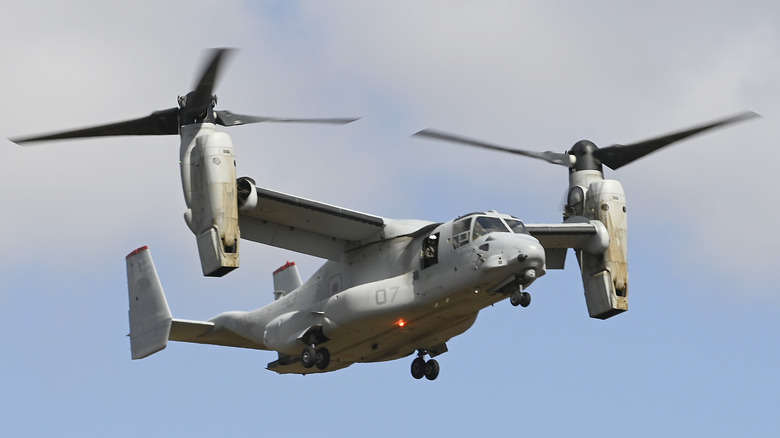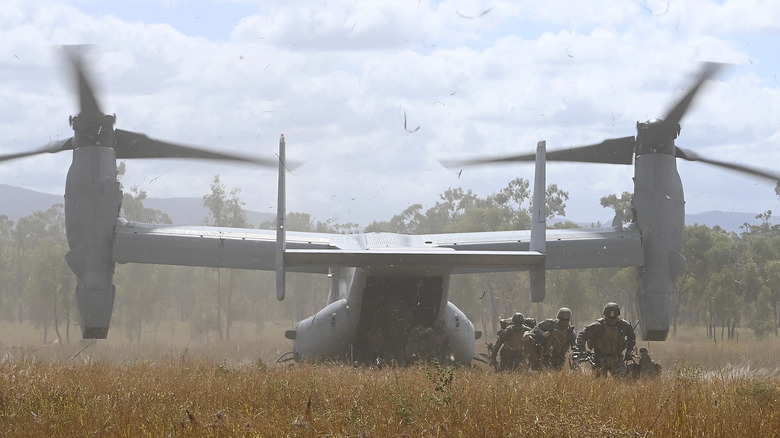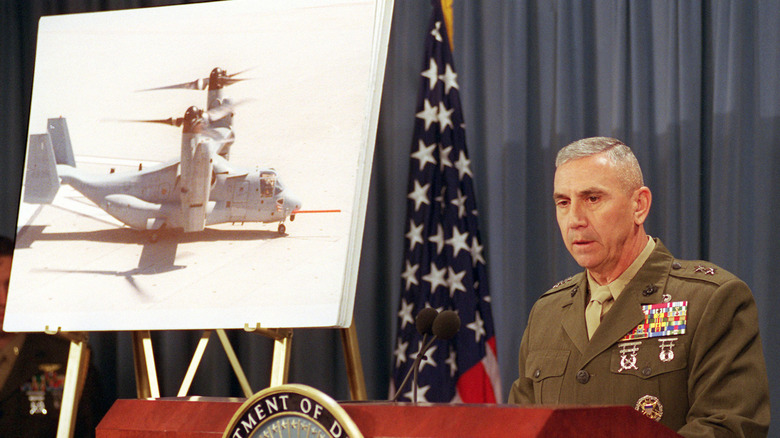The Biggest Strengths And Weaknesses Of America's V-22 Osprey
The impressive Bell Boeing V-22 Osprey is one of the U.S. military's strangest aircraft in that it operates as a helicopter and airplane. This is accomplished via its tiltrotor design, which allows for vertical takeoff and landing (VTOL) and short takeoff and landing (STOL). The V-22 was designed to fill a gap that a plane or helicopter couldn't and instead required a hybrid of both vehicles, but it took time to enter the inventory.
The V-22's origin dates back to 1981 and has roots in Operation Eagle Claw, which failed to rescue the U.S. embassy staff held captive during the Iran Hostage Crisis. Despite its development beginning in the 1980s, the V-22 didn't achieve initial operational capability (IOC) until 2007. This came after significant development and testing, with the V-22's first flight occurring in 1989. The aircraft had several problems that took time to work out, though its record is mixed.
It may not look like much, but the V-22 is a game changer and marvel of military technology and innovation, making it an incredibly complex machine. Its tiltrotor design is complex, as the V-22 can switch between operating modes mid-flight. So, it can initiate a VTOL, much like a helicopter, and then alter its configuration to transform into a fixed-wing airplane while in the air. This is a brilliant technical accomplishment, but the V-22 has several problems despite its many strengths.
The V-22 checks a lot of boxes for the Armed Forces of the United States
The V-22 was designed and built from the ground up to fill a niche, and it succeeded. The V-22 can carry 24 combat-loaded troops or 10 tons of cargo while flying at twice the operational speed of a helicopter. Its rotors can fold in as the wings rotate, making it easy to store on an aircraft carrier. Essentially, it is what it looks like: a highly mobile troop and cargo transport aircraft that is rapidly deployable to almost anywhere.
Using two Rolls-Royce AE1107C engines, the transformation from one mode to another takes 90 seconds. Each engine produces 6,150 shaft hp, enabling the V-22 to fly at a cruising airspeed of 240 knots (276 mph). It has a combat range of approximately 390 nautical miles on a single tank of gas. The V-22 can also refuel mid-air, which is something only a few helicopters are capable of achieving. This ability extends the V-22's range, allowing for a self-deployment range of 2,100 nautical miles.
While not for combat, the V-22 does have a .50 caliber machine gun for defensive purposes. These specifications make the V-22 a reliable transport aircraft capable of supporting amphibious assault and non-combat operations. Since its introduction in 2007, and as of June 2023, more than 475 orders for V-22s were placed by the Navy, Marines, and Air Force. While it certainly has many strengths, the V-22 has some weaknesses, and they're lethal.
The V-22 has a history of deadly accidents
The V-22 is a complex machine and with that complexity comes mechanical concerns. Because of this, the aircraft was in active development for 26 years, and throughout its testing period and deployment history, there have been too many fatal crashes. Between 1991 and 2000, four crashes killed 30 people, and after 2007, an additional 12 crashes and various accidents killed 32 people.
The deadliest accident occurred on April 8, 2000, when a crash near a regional airport in Arizona resulted in 19 fatalities. More recently, on November 29, 2023, a crash near Yakushima Island, Japan, resulted in the deaths of eight Air Force personnel. The staggering number of crashes and fatal accidents make the V-22 among the deadliest aircraft in the U.S. inventory; only it's killed more U.S. personnel than enemies. Outside of these accidents, the V-22 has several limitations over the aircraft it replaced.
The V-22y has one hard point for a weapon system, while the Air Force Special Operations Command's (AFSOC) MH-53 Pavelow helicopter, which it replaced, had three. The V-22 is so scantily armed due to its speed, as it was designed to overcome its lack of firepower, and it's been successful in this respect. There's also the added issue of troops preferring to avoid a vehicle with such an extensive crash history. Still, other than those limitations, the Pentagon continues ordering and operating V-22s, which filled a niche and extended U.S. deployability in all manner of operational environments.


